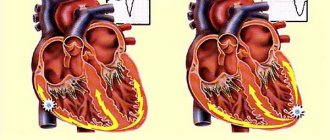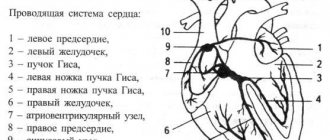Heart energy
The heart is the main worker of the human body. If we draw an analogy, the faucet in the kitchen must be turned on for more than 40 years in order to pass as much water as the amount of blood pumped through the heart of a person with an average life expectancy.
Every day, the heart spends so much energy pumping blood that it would be enough to drive a truck more than 30 kilometers. During life, the heart produces an amount of energy comparable to the energy expended by a spacecraft when flying to the Moon and back.
How long does the cough last?
To assess the clinical development of the disease, it is important to determine the nature of the cough. It can be acute, protracted and chronic. A cough is considered acute if it has been present for less than three weeks. Such a cough, as a rule, accompanies the development of acute respiratory diseases and serves to clear the airways of phlegm. Acute cough is usually persistent; that is, while a person is sick, he coughs, and a decrease in the severity of attacks and the cessation of coughing indicates recovery. If the cough returns again after some time, then we are talking about a lingering cough. A cough that lasts from 3 weeks to 3 months is considered to be protracted. Such a cough (a month or longer) means that the disease causing it develops slowly and tends to become chronic. If a cough does not leave a person for more than 3 months, it is classified as chronic. With chronic cough, periods of exacerbation alternate with periods of remission (when there is no cough). Chronic cough is also characterized by fixation - the occurrence of a cough at a certain time of day. Chronic cough is an alarming symptom because it is usually a sign of serious illness. A constant cough loses its useful function and may itself be the cause of the development of certain pathologies.
Silence of the heart
The average adult's heart beats 72 times a minute, 100 thousand times a day, 36 million times a year, and 2.5 billion times throughout a lifetime.
However, the heart beats rhythmically, which means that in addition to beats, there are also pauses in the cycle. So, if you add up all the pauses between heartbeats in one average human life, it turns out that our heart is “silent” for about 20 years. It is also interesting that the heart stops when you sneeze.
Another fact that cannot be explained from the standpoint of physics. Fluid can flow from higher to lower pressure, but in our body this law is constantly violated. When measuring pressure in the aorta and femoral artery simultaneously, blood from the aorta, where the pressure is lower, flows into the femoral artery, where the pressure is higher.
Common causes of sneezing
Among the most common causes of sneezing are the following:
- influence of all kinds of allergens;
- pungent and unpleasant odors;
- nasal polyps;
- sudden change in temperature;
- physical exercise;
- eye irritation from bright sunlight;
- cold;
- pregnancy.
Scientists say that once the sneezing process has begun, it cannot be stopped. It happens involuntarily and is not controlled in any way. If the cause is a cold, then you need to cure it.
Thanks to sneezing, foreign bodies, allergens and microbes are removed from the upper respiratory tract, which in turn maintains health.
Studies have shown that suppressing sneezing is very harmful. If you close your nose and mouth at this time, you can damage the eardrum, since the pressure at this moment is directed into the Eustachian tubes, which connect the nasopharynx and middle ear.
There are many cases in nature where people tried to stop sneezing, but their blood vessels ruptured and they experienced bleeding from the nose, headache, and sometimes blindness. This once again proves the fact that the sneezing process should under no circumstances be attempted to be stopped or prevented.
Heart and ecology
Recent research from Harvard Medical School, the results of which were published in the journal Science Dayly, has proven that one of the most negative factors for heart function is poor ecology.
The study examined medical data from 107,130 women from 1986 to 2012. Analysis of the data (comparing geographic location) showed that in 523 cases of sudden cardiac arrest, living within 50 meters of a road increased the risk of such death by 38% compared to living 500 meters from the road.
Thus, today we can already say that it is possible to reduce the likelihood of coronary heart disease - just move to the village.
Child's cough
In children, the cause of cough can also be:
- whooping cough;
- measles;
- mouth breathing. If a child constantly has a stuffy nose and is used to breathing through his mouth, cold and dry air entering the respiratory tract that has not passed through the nasal sinuses can cause irritation of the mucous membrane and cough;
- entry of a foreign body into the respiratory tract. In this case, the cough begins suddenly, the child turns red and begins to choke. It is necessary to help the child cough up a foreign object, for which you should press his chest and stomach to a hard surface, tap between his shoulder blades, or hold him upside down and shake him, tapping on his back. If help fails, the child should be taken to the hospital immediately.
"Broken heart"
The heart is one of the strongest muscles of the human body, but even the heart cannot always cope with the misfortunes that befall a person. In difficult circumstances, our “engine” has its own self-defense system. Thus, one of the heart conditions may be stress cardiomyopathy, characterized by a sharp and severe decrease in the activity of the heart muscle. This syndrome is often confused with myocardial infarction.
Stress cardiomyopathy (as the name suggests) is most often caused by severe emotional distress, which is why it is also called “broken heart syndrome.”
Unlike a myocardial infarction, there is no blockage of the coronary arteries, but the release of adrenaline helps protect the heart from overstimulation, paradoxically “pausing” the heart.
What happens when you sneeze
The human body is a very complex and complex mechanism. One little-studied process is sneezing.
According to background information, sneezing is a sudden and sharp exhalation of air through the nose or mouth, which is a protective reaction to external irritants.
This protective reflex is characteristic of both humans and animals. In some cases, sneezing is a symptom of respiratory and allergic diseases. When sneezing, the speed of exhaled air is about 160 km per hour.
The most interesting thing is that a person cannot sneeze while sleeping.
When you sneeze, the airways are deeply cleansed. The process itself affects the functioning of the circulatory system, thereby changing the pressure inside the chest.
During the research, scientists found that when you want to sneeze, a tickling sensation appears in the nose, you take a breath, close your eyes, contract the intercostal muscles and exhale sharply. At this moment, the eyes reflexively close, and the neck and head are thrown back.
Heart in weightlessness
NASA recently conducted a study that yielded very interesting results. It turned out that in a state of weightlessness the heart not only weakens and decreases in volume, but also... becomes rounder. During the experiment, NASA cardiologists studied the hearts of 12 astronauts working on the ISS.
Analysis of the images showed that in conditions of weightlessness the heart is rounded by 9.4%. However, upon returning to Earth, the heart returns to its normal shape within six months and resumes “earthly” activity. To imagine the decrease in heart activity, it is enough to say that lying on a bed for a month and a half is equivalent to working in zero gravity for a week.
What are we sneezing at? 5 ways to distinguish allergies from colds
In the spring, during sudden changes in weather, many people begin to sneeze and cough. However, these symptoms are not always a sign of ARVI. Often, an allergic disease is hidden under the mask of a respiratory infection. How to distinguish it, the assistant of the Department of Clinical Immunology and Allergology of the Institute of Clinical Medicine of the First Moscow State Medical University named after. I. M. Sechenova, Candidate of Medical Sciences Assel Nurtazina .
There are several signs that suggest that your suffering is associated with seasonal allergies and not ARVI.
1. No temperature. For all infectious diseases, the main symptom is fever. Watery nasal discharge is possible both due to allergies and a common cold. But there is usually no fever with allergic rhinitis. It is possible only in the youngest children, and as a rule, it increases slightly to 37-37.1 degrees. And this happens rarely.
2. A runny nose worsens when going outside. This is especially true at the beginning of April, when plants have not yet begun to bloom en masse and the concentration of pollen in the air is insignificant. For example, a person may notice that when he goes to the park (this is the main symptom), goes to work, school, he gets a runny nose. And when he returns home (indoors), all the symptoms disappear or decrease. In the case of viral rhinitis, on the contrary, at home in the evening the state of health will worsen and the person will have difficulty sleeping. In the future, when the concentration of pollen in the air becomes high, this symptom will not be so obvious.
3. Additional symptoms. If a person has allergies, this does not mean that he constantly sneezes or sniffles. Specific symptoms may occur: the eyes and eyelids swell, severe skin itching and lacrimation appear. When the eyes are involved, this is a manifestation of allergic conjunctivitis. And, as a rule, the doctor already suspects that there is most likely an allergy here.
5. Every spring, at approximately the same time (depending on how quickly the real, not calendar spring, came) a cough begins or snot flows. When for several seasons in a row a person notices that he gets sick in the spring, he comes to the doctor with a question: in May I have a cough all the time or snot flows all the time, it’s somehow strange, why? And then he is usually referred to an allergist.
Allergic diseases in close relatives. If someone in the family suffers from hay fever, or an allergy to pollen, then you can suspect an allergy, already knowing the symptoms. Moreover, allergies often have a hereditary predisposition. If one of the parents suffers from allergies, then the probability of its development in the child reaches 30%. If both parents - the risk can increase to 70%. Moreover, for any irritant, not necessarily the same one that caused the disease in mom or dad.
In any case, for any abnormalities in the body, it is better to consult with your doctor so as not to aggravate the situation.
Photo: fizkes / Shutterstock.com
Link to publication: aif.ru
Chronic non-allergic rhinitis
It is often associated with the anatomical features of the structure of the nasal cavity, curvature of the nasal septum, hypertrophy (thickening) of the mucous membrane. All this leads to constant nasal congestion, especially pronounced in the morning.
The natural process of cleansing the nose is accompanied by morning sneezing; the dry crusts coming off further irritate the mucous membrane, and the process may be delayed.
What to do? Contact an ENT specialist; you may need an endoscopy of the nasal cavity and sinuses and a CT scan. A possible treatment option is removal (cauterization) of excess mucous membrane and correction of the nasal septum.
Onset of a respiratory viral disease
The nasal mucosa is the first barrier to microbes entering our body. It is known that influenza viruses and respiratory viruses take hold in the first few hours after infection and begin to actively multiply on the nasal mucosa.
It is not for nothing that many infectious disease specialists advise that during a flu epidemic, upon arriving home, immediately rinse your nose. Replication (multiplication) of the virus leads to the destruction of epithelial cells of the nasal mucosa, such an irritating effect inevitably causes a reflex reaction in the form of sneezing.
What to do? Wash your hands well, try not to touch your face and eyes, and rinse your nose after visiting public places. Take antiviral drugs as prescribed by your doctor.
Esophagitis
Excessive production of hydrochloric acid in the stomach and the presence of a sliding hiatal hernia often leads to the reflux of acidic stomach contents into the esophagus. In the vast majority of people, this manifests itself as unpleasant symptoms of heartburn, and in some of them this is accompanied by reflex sneezing.
Sometimes the sick person may not feel heartburn, and sneezing attacks will be the only manifestation of the disease. A characteristic difference is that sneezing begins about an hour after eating or at night if you ate heavily before going to bed.
What to do? If the cause of sneezing cannot be determined for a long time, it is advisable to perform a gastroscopy. Signs of a hiatal hernia and esophagitis (inflammation of the esophagus) indicate a gastric cause of sneezing.
To cure, you will need to not eat 2 hours before bedtime and take antacids. In some cases, endoscopic surgical treatment is performed to eliminate the hernia forever.
Pregnancy
Pregnancy is accompanied by serious hormonal changes. Often, under the influence of hormones, hypertrophy of the nasal mucosa occurs, which causes periodic congestion and sneezing attacks, which have not been noted before. Fortunately, pregnancy is temporary, and after childbirth the mucous membrane returns to normal and the sneezing stops.
What to do? If sneezing during pregnancy greatly interferes with your life, you can try a folk recipe for combating sneezing: press your index finger on the point located directly under your nose, above your upper lip.
Allergic rhinitis
The content of the article
This is the most common cause of frequent sneezing. The nasal mucosa is the first barrier to any foreign agent. It is not surprising that it is the most severe manifestations of allergies.
Provoking agents include house dust with mites inhabiting it, plant pollen, aerosols, pet hair and many others. Immediately after contact with the allergen, the mucous membrane swells, mucus production increases sharply, all this causes a protective reaction in the form of “apchha”.
As a rule, an allergic sneeze is long-lasting and can persist until exposure to the allergen stops or an antihistamine tablet takes effect.
What to do? Visit an allergist and get tested. Identifying the allergen will help avoid unnecessary exposure and reduce medication consumption.
Irritation of the mucous membranes by chemicals
Sometimes people complain about bouts of frequent sneezing, as they say, “the whole entrance.” If this happens, call the regional department of Rospotrebnadzor; epidemiologists and hygienists should join the investigation.
There are cases in history when residents responded in this way to an emergency release of a toxic substance at a nearby plant, a leak of chemicals from a landfill, or an accident at a thermal power plant.
What to do? If your neighbors start sneezing at the same time, contact the regional office of Rospotrebnadzor or call environmentalists. Most likely, some kind of chemical has leaked.
The air is too dry
It becomes like this when the air conditioner is running or the batteries are too hot in the cold season. During a day spent in a dry room, dry, dense crusts form in the nose. They irritate the nasal mucosa and a response occurs in the form of a sneeze. Trying to remove crusts leads to even more irritation.
What to do? To make the indoor air less dry, it is recommended to use humidifiers. You can moisturize the nasal mucosa with nasal oils.








